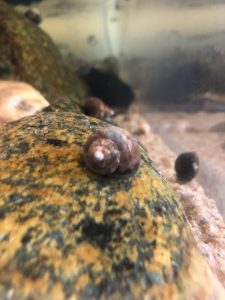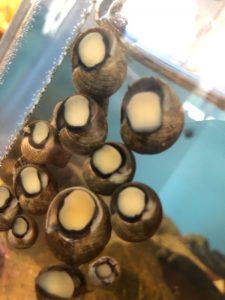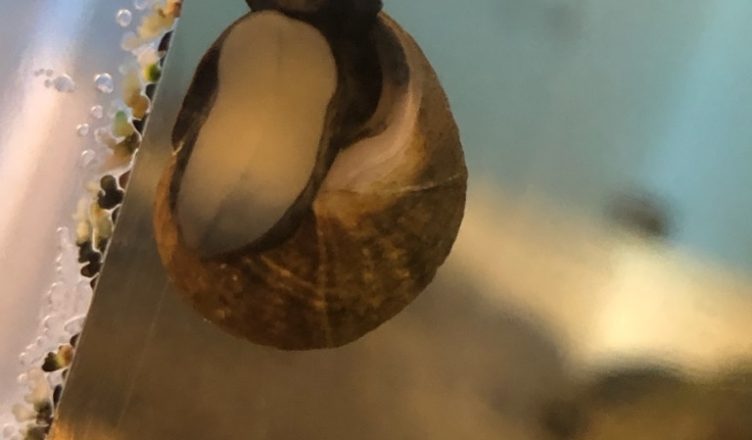This is part of our series about different animals and events at our Blue Ocean Discovery Center. This month we will discuss a Discovery Center favorite: the periwinkle. Periwinkles are a favorite animal at the Discovery Center because they are easily held and they don’t move quickly.
Identification
The periwinkle is a small snail that is easily found on rocks or pilings in the intertidal area. A young periwinkle’s shell has ridges and an adult’s shell is smooth. They are generally about ½” wide and 1” long and are brown, black or gray and blend in with the rocks. They are mollusks and move on their muscular foot. They leave a trail of mucus on rocks and a trail in sand or mud.
Alien Species

Like the Asian shore crab and the green crab, the periwinkle is an alien species in North America. They are native to the northeast coast of the Atlantic Ocean (England, Scotland, Ireland, France, Spain, Scandinavia, and Russia) and may have been brought to our area in the mid-1800’s in the ballast water of ships. Some scientists think that they may have been imported here by Europeans who wanted a familiar food. Now, the periwinkle is found from New Jersey to Newfoundland and it has displaced the native mud snail.
Will Humming Make a Periwinkle Come Out of Its Shell?
Many visitors to the Discovery Center hum to our periwinkles because they have heard that humming causes the little animal to come out of its shell. The truth is that the periwinkle will come out without humming to it! After a periwinkle is picked up it will hide in its shell but then it needs to reorient itself, so it comes out. Patience is all that is needed to see the periwinkle.
Periwinkle Anatomy
When you do hold a periwinkle look for the following parts. The operculum or “trap door shell” is visible when the animal retracts into the shell. It protects the snail from predators and from drying out. Periwinkles can live out of water for days. When the periwinkle comes out, you should see the muscular foot. You should also see the two stalked tentacles. You won’t see the radula, which is a ribbon of sharp teeth that moves like a chainsaw, but you might see the scrapes it leaves behind on rocks.

If you like to climb on the rocks in the intertidal zone, you know that they can be slippery. They are coated with algae and biofilm which is the main food source of the common periwinkle. They move across the rock with their muscular foot and use their radula to scrape off the algae and biofilm. You’ll see the periwinkles in action on the sides of our observation tanks at the Discovery Center.
We frequently see the crabs in our tanks attacking the periwinkles, and in the wild, they are also eaten by sea birds. Periwinkles are a common food source for people in Scotland, England, Wales, Ireland, Africa, and Asia. They are also used as bait.
On your next trip to the beach, be sure to hunt for periwinkles on the rocks and you can always find them in our tanks at the Discovery Center.






